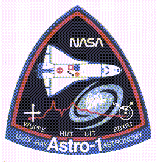|
|||||||||||||||||||
|
|
|||||||||||||||||||
|
|
 The Astro-1 Mission
The Astro-1 Mission
Launched on the space shuttle Columbia on December 2, 1990, the UV and X-ray telescopes aboard Astro-1 made 231 observations of 130 unique astronomical targets over a 10-day period. In all, the Astro-1 mission obtained 143 hours of observation time for its instruments. HUT recorded spectra in the 425- to 1850-angstrom wavelength range, with emphasis on the largely unexplored region between 900 and 1200 angstroms, UIT obtained unprecedented ultraviolet images in the 1200- to 3200-angstrom range, WUPPE made the first high quality, high signal-to-noise ratio polarization measurements of faint ultraviolet sources in the 1400- to 3200-angstrom range and BBXRT obtained X-ray spectra covering the 0.3 to 10.0 keV band. The Flight of Astro-1 provides a brief popular-level account of the mission from the HUT perspective. Many people were involved in supporting this project.
HUT Scientific Results
Observations made using HUT on Astro-1 resulted in over 50 publications both in refereed journals and in conference proceedings. A popular summary of the main scientific results obtained using HUT on Astro-1 can be found in Achievements of Astro-1. A more detailed scientific review is given by Arthur Davidsen in the review article Far-Ultraviolet Astronomy on the Astro-1 Space Shuttle Mission.
HUT Astro-1 Spectra
HUT obtained spectra of 77 individual celestial targets on Astro-1. A tabular summary of the observations lists the targets, the time of observation, the integration time, the instrument configuration, and comments on the quality of the data. Eventually the spectra listed in the summary will be linked to on-line displays of the data as illustrated by this spectrum of NGC 4151. Using an automated "ballistic" pipeline to process the raw data, flux-calibrated spectra with error bars were produced and stored on-line in FITS-format files. The HUT Data Reduction Handbook describes the ballistic reduction process, its various data products and how to interpret them; it also gives instructions for further analysis of the data.
|
|
|




 Follow Us
Follow Us